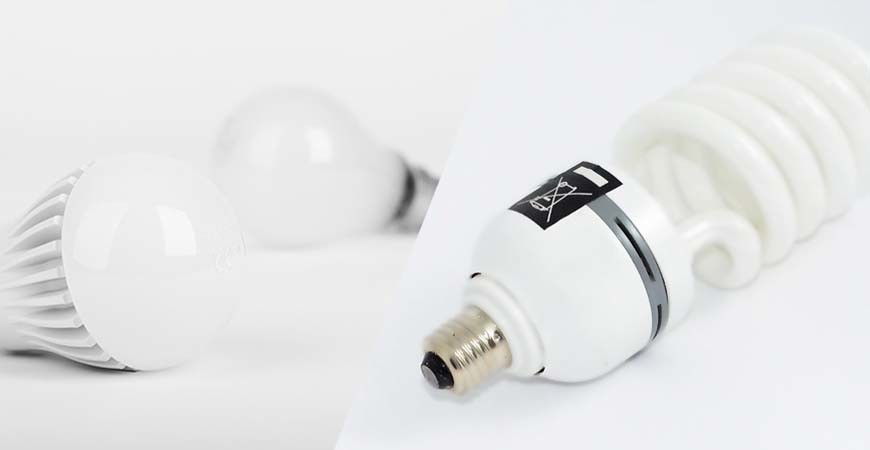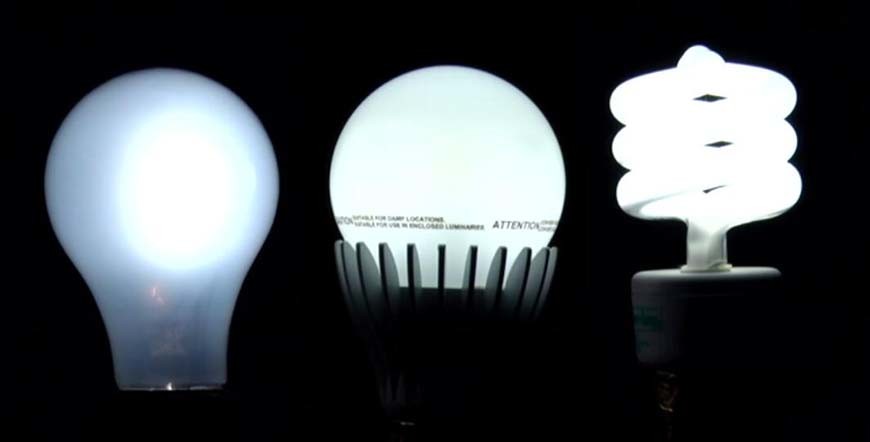
With LED light cost dropping you may be considering switching from CFL lights to LED lights. So we are going to compare equivalent CFL and LED lamps. Three main points, just looking at usage, energy savings and the lights cost.
The days of the incandescent lamp that has lighted the world for over a hundred years are numbered. The reason is simple.
Greater energy efficiency
CFLs and LEDs consume less power
Dissipate less heat
Within three minutes of turning on a 60 watt incandescent bulb. The power dissipation heat emanating from the bulb can reach temperatures exceeding 200 degrees Fahrenheit.
The 13 watt CFL bulb reached temperatures of 150 degrees Fahrenheit and climbing the equivalent LED bulb leveled off at about 70 degrees Fahrenheit.
This makes LED lighting the most efficient source of light. Unless you’re relying on light bulbs to heat a room some. People are concerned about the quality of light. They believe that CFLs and LEDs produce a harsh light compared to incandescent lamps.

What is CFL?
But please loot at the picture, all three lamps considered soft white have about the same color temperature. CFL is the acronym for compact fluorescent lamp.
All CFL lamps have essentially the same construction. They consist of the base, a ballast, a sealed tube, containing a phosphor coating with mercury vapor and argon and decorative bulbs may have a lamp cover.
What is LED?
LED is the acronym for light emitting diode.
A semiconductor that’s been around for decades. It has replay incandescent lamps as indicator lights in virtually all electronic equipment. In this nightlight example. One LED has replaced a seven watt incandescent bulb.
Advantages and Disadvantages
There is no one ideal light source. They all have advantages and disadvantages.
Some advantages of CFLs.
1 The bulb costs have become extremely affordable.
2 They’re available in a variety of sizes at affordable prices.
3 They’re available in soft white temperatures similar to incandescent.
4 Their average lifespan is longer than incandescent bulbs.
CFLs also have several major disadvantages.
1 They can take up to three minutes to achieve full brightness.
2 They should be left on at least 15 minutes to maximize bulb life.
3 Most CFLs can’t be dimmed and if used with motion sensors bulb life can be reduced to a matter of weeks.
4 CFLs are sensitive to temperature extremes.
5 Cold temperatures can severely reduce light output.
LED Advantages.
1 LEDs produce maximum light output when switched on.
2 They’re available in a variety of popular sizes.
3 They’re dimmable and work with motion sensors.
4 Available in soft white temperatures.
5 Their average life can be twice the life of a CFL.
LED Disadvantages.
1LED bulbs can cost 10 times or more the cost of an equivalent CFL.
2 They have reduced efficiency in life in hot climates.
3 Reduce life and applications restricting heat dissipation and possible.
4 Color shift with age or constant high temperature use.
Here are some considerations for selecting a CFL or LED bulb.
Energy Efficiency
Energy efficiency is one of the major considerations with power consumption measured in kilowatt hours (Kilowatt – Hour = 1000 watt-hour). A watt hour is watts times hours (Watt Hour = Watts * Hours).
A 60 watt bulb left on for one hour uses 60 watt hours which is equivalent to 0.6Kwh.
This is 60W * 1hr = 60Whr = 0.06kWh.
A 60 watt incandescent bulb is equivalent to a 13 watt CFL, and a 9.5 watt LED.
Incandescent Bulb.
A 60 watt bulb used two hours per day, 365 days per year will use 43.8 kilowatt hours. At 14 cents per kilowatt-hour, each bulb uses 6.13 dollars of electricity per year.
0.06 * 2 * 365 = 43.8kWh
Energy cost = 0.14 * 43.8kWh = $6.13 per bulb
CFLs
A 13 watt equivalent CFL uses 78% less energy. Each 13 watt CFL would use $1.33 worth of electricity.
0.13 * 2 * 365 = 9.49kWh
Energy Cost = 0.14 * 9.49kWh = $1.33 per bulb
LEDs
A 9.5 watt LED uses about 84% less energy than a 60 watt incandescent bulb. Each bulb would cost about 1 dollar per year to operate.
0.0095 *2 *365 = 6.94kWh
Energy Cost = $0.14 * 6.94kWh = $0.97 per bulb
Annual Cost Saving
Based on annual cost per year, the LED bulb would use about $0.36 less energy per bulb per year compared to a CFL. The annual energy savings converting 20 incandescent bulbs to CFLs is about 96 dollars per year.
20pcs 60W Incandescent Annual Cost = 20 * $6.13 = $122.6
20pcs 13W CFL Annual Cost = 20 * $1.33 = $26.6
Annual Saving = $122.6 – $26.6 = $96
Converting twenty CFLs to LEDs would reduce your energy costs by about $7.2 per year.
20pcs 9.5W LED Annual Cost = 20 * $0.97 = $19.4
20pcs 13W CFL Annual Cost = 20 * $1.33 = $26.6
Annual Saving = $26.6 – $19.4 =$7.2
Looking at energy savings alone. If an LED bulb costs $10 and an equivalent CFL $1, it would take over 10 years to recover the cost of the bulb alone. A bulb used 2 hours per day is on 14600 fourteen hours over 20 years depending on usage.
A CFL bulb has about a 2 – 5 year life. Assuming an LED bulb lasts 10 years an equivalent CFL bulb. May be replaced 2 – 5 times during that period. For inaccurate cost savings, you need to look at the CFL energy and bulb cost versus the LED energy and bulb cost.
Actual cost savings depends on how often you need to replace a bulb. If you replace CFL bulbs 5 times over 20 years about once every 4 years, it actually cost less to operate CFLs versus LEDs. If CFL bulb life is only 2 years and you replace the bulbs 10 times over 20 years. LED bulbs could save you over $100 over the 20 year period.
CFLs vs LEDs
CFLs
Based on current energy and bulb prices, CFLs can be more economical at this time than LEDs. Especially if you have solar panels and reduced energy costs in areas where bulbs are only on for 15 minutes or less consider using LEDs.
LEDs
LEDs are the ideal choice in areas with motion sensors and dimmers.
LEDs provide maximum light output when turned on to maximize the life of LED bulbs.
Use in areas with adequate ventilation.





